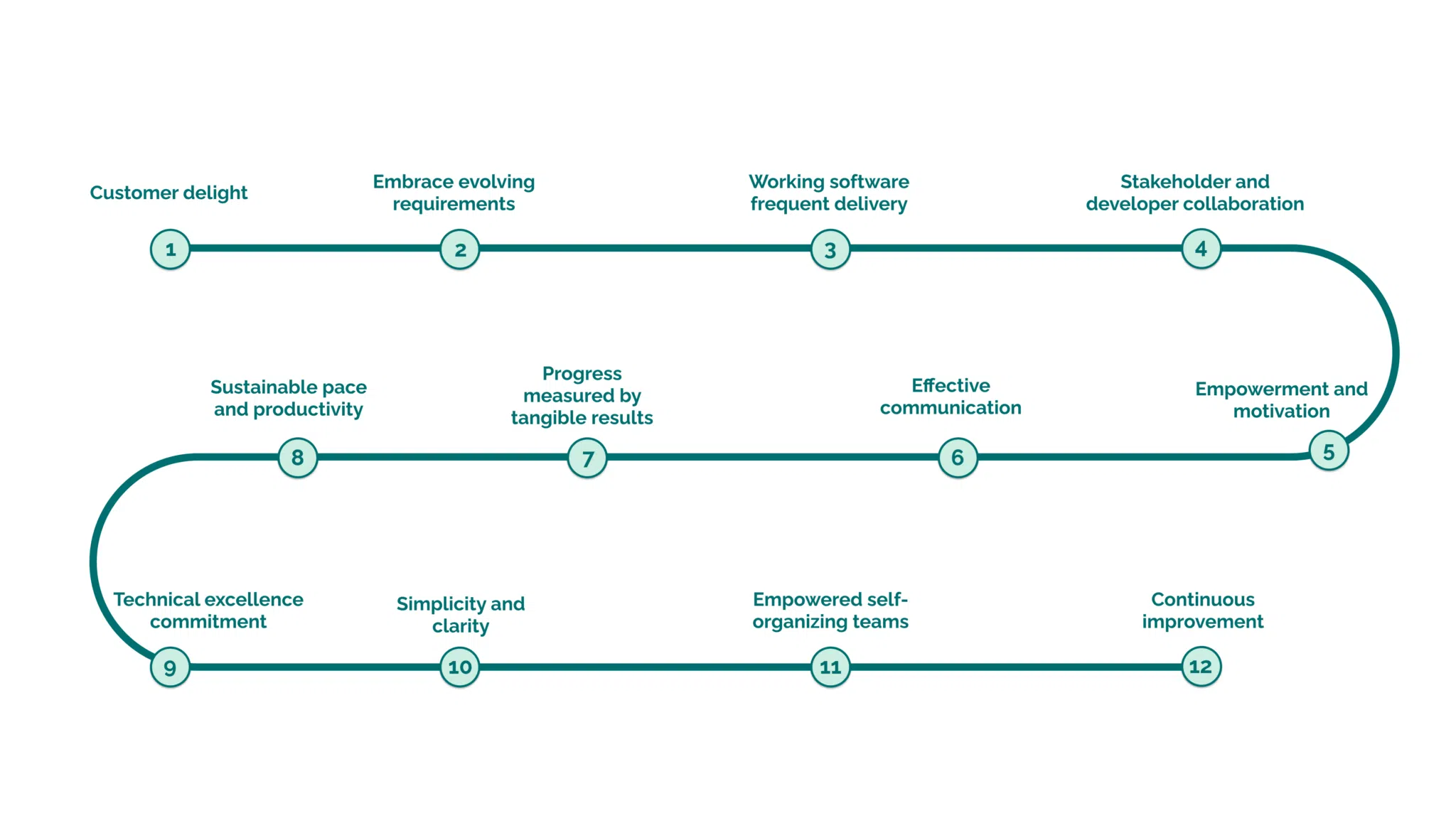Agile Methodology in Software Engineering: What You Need to Know?
Have you ever heard of Agile methodology in software engineering? It’s a turbo boost for your team’s coding efforts! Unlike the old-school waterfall methods, Agile is all about flexibility and speed. Picture it as breaking down your project into these dynamic sprints, where you build, reflect, and tweak as you go. It’s all about constant improvement and delivering results faster.
In this article, as a leading software development company, Savvycom will dive deep into how Agile can supercharge your software engineering process and get your product to market in record time. Let’s get started right away!

Using Agile methodology in software engineering to maximize effectiveness
Understanding Agile Methodology in Software Engineering
What are Agile Methodologies?
Agile development prioritizes people and their interactions over procedures and equipment. It emphasizes rapid creation of functional software, regular customer collaboration, and adaptability to change. Unlike traditional approaches, which focus on delivering complete applications, Agile development focuses on clean delivery of discrete software components.
This cultural shift is particularly beneficial for complex projects with ambiguous criteria. It supports teams in dynamic environments, ensuring effective delivery of business value. Collaborative culture enhances organizational efficiency as teams understand their distinct roles. Continuous testing throughout development ensures high-quality software delivery, allowing for timely adjustments and issue notifications.
However, although Agile development has largely replaced waterfall as the dominant methodology, it faces competition from DevOps. Agile emphasizes iterative development and collaboration, while DevOps integrates operations, enabling faster delivery, higher quality, and improved alignment. As organizations seek to optimize software development, choosing between Agile and DevOps becomes crucial, with each offering unique benefits and challenges.
Core Values in Agile Methodologies
The Agile Manifestof was developed in 2001 as a result of discussions with 17 software development experts around the notion of lightweight software development. The 4 core values outlined in Agile Methodologies are:
- Individuals and Interactions over Processes and Tools
Agile recognizes that successful software development relies heavily on effective collaboration and communication among team members. It values the skills, creativity, and insights of individual team members and emphasizes the importance of interactions within the team. While processes and tools are essential, Agile places greater emphasis on fostering a collaborative environment where team members can work together efficiently.
2. Working software rather than documentation
Agile Methodologies prioritizes delivering functional software that can be continuously tested and improved rather than long cumbersome lists of documented requirements. This iterative approach allows for features to be delivered early and often, allowing stakeholders to provide feedback and adjusts as needed.
3. Customer Collaboration over Contract Negotiation
By collaborating closely with customers throughout the development process, Agile development teams gain a better understanding of their needs, preferences, and priorities. This ongoing collaboration enables teams to deliver solutions that align more closely with customer expectations and requirements. Instead of relying solely on formal contracts and agreements, Agile development teams prioritize building trust and fostering transparent communication with customers.
4. Respond to change
Instead of rigidly following a fixed plan, Agile teams embrace change and adjust their approach based on requirements, feedback and evolving market conditions. Agile methods emphasize flexibility, allowing teams to adjust priorities, allocate resources, and make adjustments as needed to effectively deliver customer value.
12 Principles of Agile Methodology

12 Principles of Agile Methodology in Software Engineering
- Customer delight: Agile methodologies prioritize exceeding customer expectations by delivering valuable software solutions that resonate with their needs and desires.
- Embrace evolving requirements: Agile teams welcome changing requirements as opportunities for innovation and improvement, ensuring that the software remains adaptable to evolving market demands.
- Working software frequent delivery: Agile development promotes a rapid and iterative approach to software development, enabling teams to deliver functional software increments quickly and continuously gather feedback for refinement.
- Stakeholder and developer collaboration: Agile development fosters a collaborative environment where business stakeholders and development teams work closely together to ensure that software solutions align with business objectives and customer needs.
- Empowerment and motivation: Agile principles empower team members by providing them with autonomy, support, and recognition, fostering a culture of motivation and commitment to project success.
- Effective communication: Agile Methodologies encourages clear and direct communication among team members, fostering better understanding and alignment of goals, which ultimately leads to more successful project outcomes.
- Progress measured by tangible results: Agile Methodologies values tangible outcomes over process adherence, with working software serving as the primary measure of progress, ensuring that teams stay focused on delivering value to stakeholders.
- Sustainable pace and productivity: Agile development emphasizes maintaining a sustainable pace of work to prevent burnout and ensure consistent productivity, enabling teams to deliver high-quality software over the long term.
- Technical excellence commitment: Agile development teams prioritize technical excellence and continuous improvement to deliver software solutions that are robust, scalable, and maintainable in the long run.
- Simplicity and clarity: Agile Methodologies promote simplicity in both software development and processes, enabling teams to deliver solutions that are easy to understand, maintain, and scale.
- Empowered self-organizing teams: Agile principles empower teams to self-organize and make decisions collaboratively, fostering a culture of innovation, adaptability, and accountability.
- Continuous improvement: Agile development encourages regular reflection and adaptation to drive continuous improvement, ensuring that teams learn from their experiences and optimize their processes for future success.
Looking For a Trusted Tech Partner?
We’ll help you decide on next steps, explain how the development process is organized, and provide you with a free project estimate.
Types of Agile Methodology in Software Engineering
There are several types of Agile methodologies, each with its own approach to software development. Some common types include:
1. Scrum
Scrum prioritizes task management within team-based development settings. Originating from the dynamics of a rugby match, Scrum advocates for small, empowered teams typically comprising 7 to 9 members.
In Scrum, the Product Backlog serves as a prioritized list of features, enhancements, and bug fixes for the product. Managed by the Product Owner, it undergoes continuous refinement and prioritization based on business value and customer feedback.
Scrum Practices:
- Sprint Planning: At the start of each sprint, the team collaborates to select items from the Product Backlog to work on.
- Daily Stand-up: A daily meeting where the team discusses progress, identifies obstacles, and plans their tasks.
- Sprint Review: Held at the end of each sprint, the team presents completed work to stakeholders for feedback.
- Sprint Retrospective: Following the review, the team reflects on their process, identifies areas for improvement, and makes adjustments.
2. Extreme Programming (XP)
Extreme Programming is the foundation of the Agile methodology, known for efficiently promoting high-quality software development. XP advocates a holistic approach that emphasizes iterative code refinement through continuous feedback loops and prioritization of essential features.
Courage and respect help XP teams tackle challenges, foster trust, and support each other to continuously improve without fear of judgment. This helps deliver solutions that are robust, easy to maintain, and evolve over time while promoting adaptability and nurturing collaboration and transparency among team members.
XP’s technical practices, including pair programming, test-driven development (TDD), continuous integration (CI), and refactoring, promote excellence in software development, leading to quality Higher code and increased productivity. In particular, automated testing is the main focus of XP, ensuring reliability and maintainability of software products, allowing faster delivery cycles without compromising quality.
3. Adaptive Software Development (ASD)
Adaptive Software Development (ASD) was developed by Jim Highsmith and Sam Bayer in the mid-1990s. It embraces continuous adaptation, emphasizing the dynamic process of learning, collaborating, and speculating. This approach prioritizes close customer involvement and ongoing learning to navigate the ever-changing business environment effectively.
Unlike traditional software development methods with static life cycles, ASD adopts a non-linear iterative approach. Each phase can iterate and evolve independently, fostering rapid application development to deliver high-quality, engaging products efficiently.
Key characteristics of ASD include:
Speculate:
- Establishing project objectives and goals.
- Maintaining team coordination to share insights and minimize risks.
- Focusing on development activities.
Learn:
- Engaging in multiple collaboration cycles to capture lessons learned.
- Iterating based on both positive and negative experiences to drive project success.
4. Dynamic Software Development Method (DSDM)
In 1994, a consortium of software developers and suppliers introduced the Dynamic Software Development Method (DSDM), tailored for projects with limited budgets and time constraints. DSDM emphasizes consistent product delivery through incremental and gradual growth.
DSDM enables the creation of project plans featuring ongoing and early deliveries, facilitating incremental solutions and responsive changes based on feedback. This agile model empowers organizations accustomed to traditional project approaches to shift their mindset and operations, enhancing their ability to generate value and expedite time-to-market.
5. Feature Driven Development (FDD)
Feature-Driven Development (FDD) stands out among Agile methodologies for its precise and concise work phases tailored for each feature. These phases include domain walkthrough, design review, promotion to build, code review, and design, ensuring a focused approach to product development.
- Visibility of progress and results
- Regular Builds
- Configuration Management
- Inspections
- Feature Teams
- Component/ Class Ownership
- Development by feature
- Domain object Modeling
6. Kanban
Kanban stands out as a visually oriented workflow management method that facilitates active monitoring of the product creation process while ensuring a stress-free software development lifecycle. Widely applied in Lean software development methods, the core principles of Kanban revolve around visualizing workflow, limiting work in progress, and optimizing workflow.
Specifically, Kanban provides teams with a visual representation of their work, assisting in tracking progress, identifying bottlenecks, and prioritizing tasks. By setting limits on work in progress, Kanban promotes a steady pace of development, prevents overload, and promotes focused task completion.
Furthermore, Kanban fosters collaboration and continuous learning within teams, promoting transparency and accountability. With a focus on visualizing workflows and limiting work in progress, Kanban enables teams to identify areas for improvement and make incremental changes, driving continuous efficiency. continuously and increase productivity.
7. Behavior Driven Development (BDD)
Behavior-driven development (BDD) is an agile software development approach that revolves around behavior rather than technicalities. Developed by Dan North in 2003 as an extension of TDD, BDD aims to involve non-technical stakeholders in the development process. By incorporating universal language concepts, BDD facilitates communication among team members with varying technical expertise. This approach emphasizes writing test cases and features to define system requirements and standards. BDD enables teams to express needs effectively, identify faults promptly, and deliver robust software solutions.

7 Types of Agile Methodology in Software Development
Agile Methodology in Software Engineering: Pros and Cons
Let’s dive into the nuanced world of Agile Methodologies to discover its inherent benefits and challenges. A better understanding of how Agile practices promote adaptability and teamwork will also help you navigate potential pitfalls for a successful implementation.
Pros
The integration of Agile development practices into software engineering workflows presents a wide array of advantages. By adopting Agile methodologies, organizations can streamline their development processes, accelerate time-to-market, and ultimately drive business growth through customer-centric software solutions
Flexibility and Rapid Adaptation
Agile methodologies enable teams to swiftly respond to changing needs, priorities, and market dynamics. This adaptability ensures that projects stay on track and aligned with evolving requirements, maintaining focus on delivering value.
Elevated Team Morale and Engagement
Agile fosters a collaborative and supportive work environment, fueling team morale, motivation, and enthusiasm. This positive atmosphere translates into increased productivity and better outcomes for projects.
Heightened Client Delight
Agile methodologies prioritize customer satisfaction by involving clients throughout the development journey. This active engagement ensures that software solutions precisely meet client needs and expectations, leading to greater satisfaction and loyalty.
Cons
Agile’s flexibility, if not carefully managed, may result in scope creep, project instability, or problematic for remote teams. Maintaining a balance between client engagement and project schedules is vital, demanding adept project management to navigate risks and achieve desired results effectively.
Uncertain Predictability
Agile methodologies emphasize adaptability and continuous feedback, which can make it difficult to forecast project outcomes, timelines, and budgets accurately. This lack of predictability can pose challenges for project planning and resource allocation.
Complex Scope Management
While Agile allows for changes in project scope to accommodate evolving requirements, it also introduces the risk of scope creep. Without proper control mechanisms, the project scope may expand beyond initial expectations, leading to increased complexity and potential delays.
Testing and Quality Assurance Focus
Agile promotes rapid delivery of working software through iterative development cycles. However, this focus on speed may sometimes come at the expense of thorough testing and quality assurance processes. As a result, there could be an increased risk of undetected defects and issues surfacing later in the project lifecycle, impacting overall product quality.
7 Steps of Agile Software Development Cycle
The Agile Methodologies cycle is a dynamic process that revolves around continuous iteration and adaptation, comprising several distinct phases:

Agile Software Development Cycle in 7 Steps
Step 1: Initiation and Planning
The project kicks off with thorough planning, where the team defines project goals, scope, and initial requirements. This phase involves creating a backlog of features and prioritizing them based on business value.
Step 2: Iteration Planning
Broking down the project into short iterations, typically lasting 2 – 4 weeks. During iteration planning, the team selects a subset of features from the backlog to work on in the upcoming iteration.
Step 3: Execution
With a clear plan in place, development work begins. The team collaborates closely, often in daily stand-up meetings, to ensure progress and address any impediments. Continuous integration and automated testing are employed to maintain code quality.
Step 4: Review and Feedback
At the end of each iteration, a review meeting is held to showcase the completed work to stakeholders. Feedback is solicited and incorporated into future iterations, ensuring that the product evolves in alignment with customer needs and expectations.
Step 5: Retrospective
Concurrently with the review, the team conducts a retrospective to reflect on what went well and what could be improved. Lessons learned are documented, and process improvements are implemented to enhance efficiency and effectiveness.
Step 6: Delivery
As iterations progress, shippable increments of the product are delivered to customers or stakeholders. This incremental delivery allows for early validation and ensures that the product remains aligned with evolving requirements.
Step 7: Continuous Improvement
The team prioritizes continuous improvement throughout the development cycle. This involves refining processes, enhancing collaboration, and embracing change to deliver maximum value to customers.
Throughout the Agile cycle, new items can be continuously added to the product backlog. The process involves iterating through each phase until all backlog items are addressed, transforming the Agile cycle into a dynamic loop rather than a linear progression. Enterprises often manage multiple projects concurrently, with iterations spanning various product lines and catering to diverse internal and external clients, each with unique business needs.
For a deeper dive into how the agile methodology really works, watch this informative video:
Final Thought
With the ability to flexibly backtrack and work incrementally of Agile methodology in software engineering, Agile teams tackle features, bugs, and evolving requirements head-on. Through cross-functional collaboration, continuous communication ensures everyone is united in pursuing a common vision. Whether you’re learning about Scrum, Kanban, or other Agile frameworks, remember: it’s not just about software development, it’s about empowering teams to grow faster and adapt to seamless change.
Tech Consulting, End-to-End Product Development, Cloud & DevOps Service! Since 2009, Savvycom has been harnessing digital technologies for the benefit of businesses, mid and large enterprises, and startups across the variety of industries. We can help you to build high-quality software solutions and products as well as deliver a wide range of related professional services.
Savvycom is right where you need. Contact us now for further consultation:
- Phone: +84 24 3202 9222
- Hotline: +1 408 663 8600 (US); +612 8006 1349 (AUS); +84 32 675 2886 (VN)
- Email: [email protected]

![Why Quality Assurance In Software Engineering Is Important? [2025]](http://savvycomsoftware.com/wp-content/uploads/2024/12/41685-150x150.jpg.webp)
